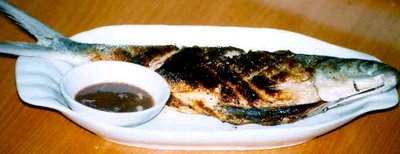
[Grilled Milkfish]
May 1 is observed across the globe as Labor Day. As the day falls on a Monday this year, it translates to a long weekend, as it is usually declared a special non-working holiday. An opportune time to schedule that long-postponed vacation trip.
Pangasinenses attach a special meaning to May 1, but for another reason. Because May 1 had also been observed for years in the province as Písta'y Dáyat, literally translated as "Feast of the Sea," which is a celebration in thanksgiving for the seas' bountiful harvest.
So it means a trip to the beaches surrounding the Lingayen Gulf, going across Tondalígan (or Blue Beach) in Dagupan City all the way to San Fabian which borders La Union.
One of the highlights of the celebration is the pageant to choose the Limgás na Dáyat, the "muse of the sea," (literally translated, limgás means purity), and her eventual coronation around midnight.
The past several years saw the stretching of the festival to about a month of activities, like all other festivities that have seen the light of commercialization, especially with the bid for fame with the longest bangós* grilling station in the world. That development has since segregated the celebration to each municipality, with the festival in Dagupan City renamed to Bangós Festival, to properly attribute the source of the best bangós.
I've never attended a Písta'y Dáyat, for the simple reason that crowded beaches can be one of the most disgusting places in the world to be in, due from both the wastes littering the otherwise pristine waters and humans wasted by alcohol and too much karaoke. Even during the other holidays of the year we avoid the beaches like the plague.
But, of course, that doesn't keep me from commemorating the occasion. Just rub a fresh Bonuan bangós with coarse sea salt (from Pangasinan, of course) and plop over live coals, innards intact (excluding the gills and minute bile sac), grilling until the scales blacken.
Eating the hot, succulently sweet, fatty flesh dipped in Lingayen bagóong with a squeeze of calamansi is always a cause for celebration, for me. Even the scorched, sea-salty scales are not spared by Pangasinenses, as we eat the entire skin, leaving only the tail and big spine (the head is sucked to pieces).
The only things missing then would be the sand under my toes and the whiff of sea breeze playing with my hair.
But with bangós production on full scale across the country, buying real Bonuan bangós can be actually tricky. All bangós vendors in Pangasinan will say their bangós is from Bonuan, when about fifty percent of the time it is not. There are other bangós ponds in the province, after all. And some Pangasinan bangós can be maáblir, smelling and tasting like mud.
A skill is most of the time needed to differentiate the real Bonuan bangós from that just pretending to be one. But the most telling characteristic of a Bonuan bangós is its size - so great is the demand that it is rarely harvested past its prime length, which is about 6-8 inches. A jumbo bangós is from elsewhere and is best made into a relleno.
A small head (relatively stunted) and short tail, which means a longer body, are also characteristic traits of a Bonuan bangós, as an uneven tail (one prong is shorter than the other, although not so obvious at first glance). Scales are light grey turning to white, easily rubbing off. Bonuan bangos usually look like they've been harvested days before because of the missing scales, but that is the best and the most obvious indicator that they really come from Bonuan.
A bulging stomach is considered first-rate bangós, as it spells heavenly thick fat that enhances the flavor of the fish as it grills. Pangasinenses are self-avowed bangós belly worshippers, including and especially those who eat bangós as pulutan. The latter always offer prayers for a miracle that would turn the bangós into an all-belly fish, the thick, black fat running from head to tail.
Such is this obsession that all bangós sold in the province have slit bellies to show how thick the fat is, which also shows how fresh the fish is from the overflowing innards. Which is to say, it would be unwise to buy bangós without the proper incision.
*Commonly spelled bangus
Related Posts
Beach-Bumming
Sinigang na Bangus
Sinigang na Bangus sa Santol
5 comments:
I love grilled bangus so much especially with calamansi/patis dip, hay, ang figure!
i have this waiting to be posted in my blog. been kinda lazy..hehe. looks delicious.
Hmmm...I feel hungry now as I smell the picture of your "Inkalot Ya Bangus"... I miss those day to wake up like 2AM and join the "Gilon Gang" and as beforethe sun comes up from the horizon we grill some of the catch in the "pinangalab ya kukut" at the "pilapil"
How about post in your blog the sinigang na "malaga" sa "kamatis" at "agat"
Sorry for those pangasinan words.. it let me remembers the old folks that used to work with.
Bert
thanks for the info about bonoan bangus. now, i'll see if i can detect the real one following your tips.
Lani, don't worry, fish is beautifying, hehe!
Dexiejane, had this in the archives for ages, too, haha! Just had the motivation to post it in time for Pista'y Dayat.
Hi, Bert, I'm racking my brains for Gilon gang, it sounds so familiar but I can't place it. But yes, the kukut! The malaga is in the works, don't worry!
Yo, you'll have minimal luck in Metro Manila, will try to bring you some.
Post a Comment